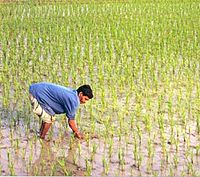
Photo from wikipedia
Soil phosphorus (P) is an essential element that is often limiting in ecosystems. Excessive use of P fertilizers has led to P loss from soil and introduction into the environment.… Click to show full abstract
Soil phosphorus (P) is an essential element that is often limiting in ecosystems. Excessive use of P fertilizers has led to P loss from soil and introduction into the environment. However, the behavior and potential risk assessment of P in alkaline soils is not well studied. Therefore, soil sampling was performed in alkaline soils in the northern Nile Delta, Egypt. Three analytical procedures (i.e., Mehlich 3 (P M3 ), Olsen (P Olsen ), and Bray 1 (P Bray ) solutions) were used to evaluate P availability and potential environmental risk from P loss. Selected soil properties were determined using standard methods. Mean values of P extracted were in the order P M3 > P olsen > P Bray , and were significantly correlated with each other. The P M3 was the highest in silt clay loam and lowest in sandy and loamy soils. To predict potential P loss from the soils, degree of P saturation (DPS), soil P storage capacity (SPSC), and P stability ratio (P sat ) were calculated. Results showed the highest DPS was recorded in sandy textured soils, indicating that they have lower sorption capacity, whereas the SPSC was highest in silt clay textures; hence, it is likely they would act as a P sink. P sat was highest in sandy soils, which indicated a high risk for P leaching. Principal component analysis (PCA) performed on the data identified four principal components that described 83.8% of the variation between P and the studied soil parameters. The results indicated that silt was the critical soil characteristic associated with both P sorption and extractability in different textures of soil. The second component confirmed the positive association between the different soil P extraction methods (P M3 , P Olsen , and P Bray ).
Journal Title: Agriculture
Year Published: 2020
Link to full text (if available)
Share on Social Media: Sign Up to like & get
recommendations!